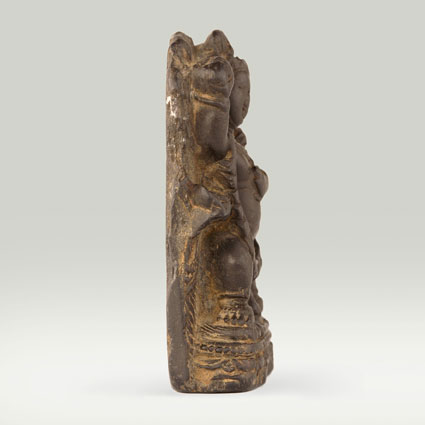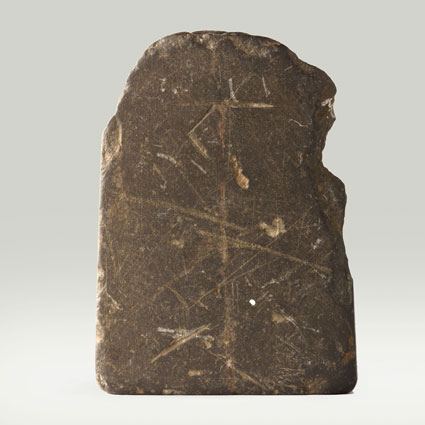ABS 171
Code: ABS 171
Country: India (north-east)
Style: Late Pala Style
Date: 1050 - 1150
Dimensions in cm WxHxD: 4.7 x 6.5 x 1.8
Materials: Stone
Also known as Acalanatha, Aryacalanatha, Acala-vidya-raja and Candamaharosana. In Vajrayana Buddhism, Acala (alternatively, Achala or Acala) is the best known of the Five Wisdom Kings of the Womb Realm. Acala means "The Immovable One" in Sanskrit. Acala is also the name of the eighth of the ten stages of the path to buddhahood.
Acala is the destroyer of delusion and the protector of Buddhism. His immovability refers to his ability to remain unmoved by carnal temptations. Despite his fearsome appearance, his role is to aid all beings by showing them the teachings of the Buddha, leading them into self-control.
He is seen as a protector and aide in attaining goals. Temples dedicated to Acala perform a periodic fire ritual in devotion to him.
The buddha Akshobhya, whose name also means “the immovable one”, is sometimes merged with Acala. However, Acala is not a buddha, but one of the Five Wisdom Kings of the Womb Realm in Vajrayana as found in the Indo-Tibetan tradition, as well as the Japanese Shingon sect of Buddhism. As 'Fudo myo-o', Acala is considered one of the Thirteen Buddhas in Japan
Iconography
Acala is typically depicted with a sword for subduing demons in his right hand and a rope for catching and binding them in his left hand. He has a fearsome blue visage and is surrounded by flames, representing the purification of the mind. He is often depicted seated or standing on a rock to show his immovability. His hair commonly has seven knots and is draped on his left side, a servant hairstyle in Buddhist iconography. He is frequently depicted with two protruding fangs. One tooth points down, representing his compassion to the world, and one tooth points up, representing his passion for truth.
Chandra, Lokesh, 1991. Buddhist Iconography of Tibet (CBIT). New Delhi: International Academy of Indian Culture & Aditya Prakashan. Nos. 13, 187, 202, 322, 682-687, 775, 934-935, 2377 (174), 2422 (219) - References to the iconography of Acala
Cornu, Philippe , 2001. Dictionnaire Encyclopédique du Bouddhisme. Seuil. Pp. 33-34
de Mallmann, Marie-Thérèse, 1963. “Notes d’iconographie tântrique: III. A propos du Fudô bleu [Acala]”, Arts Asiatiques. Tome IX, Fasc. 1–2. EFEO, Musée Guimet. Pp. 73-79, fig 1 - References to the iconography of Acala
de Mallmann, Marie-Thérèse, 1964. Étude iconographique sur Manjusri. Paris: École Française d’Extrème-Orient. Pp. 16, 30, 32, 70-71, 111-112, 128-32 - References to the iconography of Acala
de Mallmann, Marie-Thérèse, 1975. Introduction à l'iconographie du tântrisme bouddhique. Paris: Adrien Mainsonneuve (Jean Maisonneuve successeur (1970). Pp. 83-85 - References to the iconography of Acala
Frédéric, Louis, 1992. Les Dieux du Bouddhisme. Guide iconographique . Paris: Flammarion. P. 201, sq - Sur l'iconographie d'Acala
Rambach, Pierre, 1978. Le Bouddha secret du tantrisme japonais. Genève: Skira . Sur l'iconographie d'Acala
von Schroeder, Ulrich, 2001. Buddhist Sculptures in Tibet. Vol. One: India & Nepal; Vol. Two: Tibet & China. Hong Kong: Visual Dharma Publications, Ltd.. Vol. Two: Tibet & China, pp. 1038-1039, 1112-1113; Pls. 259, 291 - Compare with other images of Acala





